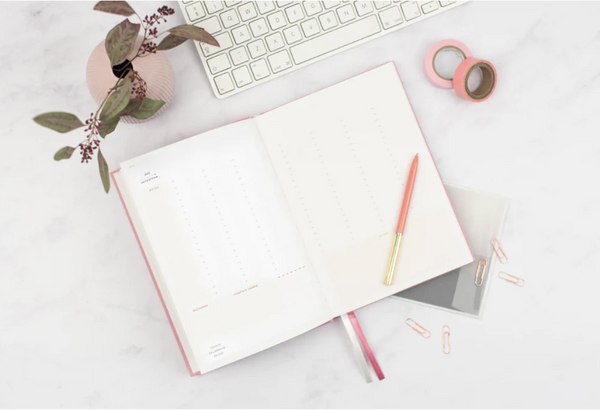
Increasing Productivity With Personal Planning
I recently sat down with the lovely Erika Peter for a conversation about increasing productivity in general. The conversation was so incredible that I knew I had to share some of the main topics discussed in greater detail with you here. Read on if you’re interested in learning how to increase productivity through personal planning!
THE WHY: How Increasing Productivity With Personal Planning Can Change Your Life
As a mother who runs several businesses, I know firsthand how stressful a busy schedule can be. I also know firsthand how much time is gained–and how much stress is alleviated–when we take the time to figure out how to increase productivity through personal planning. Figuring out how to master my schedule benefited my professional, financial, personal, and spiritual life in monumental ways. Now, I have enough free time for my family, friends, hobbies, businesses, entertainment, and travel. Once I made more space for meaning in my own life, it became my ultimate goal to help women do the same.
In this blog post, I’m going to share the benefits of increasing productivity, the difference between productivity and efficiency, the personalization of productivity, and finally, how to increase productivity with personal planning. Because I want you to master your schedule–so that you can make space for more meaning in your life.
THE WHAT: The Difference Between Productivity and Efficiency
Before we get into the nitty gritty of how to increase productivity, it’s extremely important that we first establish the difference between productivity and efficiency. Productivity refers to the quantity of work that is produced—how much you’re doing. Efficiency refers to the quality of how you’re working—how many resources are you depleting to produce that work?
So, while productivity measures the bulk output of how much we can do within a given amount of time, efficiency measures how much of that output works as intended. Ideally, we’re able to work as productively and efficiently as possible.
Think of productivity as the foundation of your workflow, while efficiency represents the oil that keeps the productivity machine running smoothly. Figuring out how to master our schedules—how to increase productivity—first—is vital. Once that has been established, then we can focus on efficiency.
THE HOW: How to Increase Productivity
Okay, lovely. We’ve established what productivity is, and why you should be aiming to fine-tune it in your workflows. Now, we’re going to get into the nitty gritty. How do you increase productivity? Be mindful that everyone is different, so there is no one-size-fits-all approach to increasing productivity. With that being said—there are universal tips that are sure to be helpful to all. So, let’s get into it!
1. Identify Your Unique Productivity Style
Productivity is personal. What works for one person is not guaranteed to work for another. This is why the very first thing I recommend for increasing productivity is figuring out which productivity style you embody. Are you a big-picture thinker, or is focusing on the details more important for your work processes? Do you need everything to be organized, color-coded, and tidy in order to function at your best? Or do you thrive in chaos?
Understanding your productivity style will help you reframe and redefine the tasks involved in your daily workflow, which will keep you from feeling overwhelmed—so you can feel empowered enough to get things done in the way that suits your unique productivity style. Like Beyoncé said: “Unique: that’s what you are.” If the queen said it, it must be of utmost importance. I don’t make the rules.
2. Tailor Your Time-Management Tools to Suit Your Needs
Much like your productivity style, your organizational and personal planning style is unique to you. Do you use a planner? You’re probably not that surprised that I’m a huge planner advocate! But do you visualize your weeks starting on Monday? Or do you consider Sunday the “start” of the week like in traditional calendars? There are planners available representing both the “Monday start” and the “Sunday start” week layouts. If you’re accustomed to visualizing your time one way, you shouldn’t expect to increase productivity by using a tool which presents time in another way. Use the tools that make sense for you. There are even undated planners available in case you need extra start date flexibility.
If you’re a big-picture visualizer—and you need to see your whole month in front of you in order to fully grasp your workload, goals, and tasks—you can easily do that with a wall calendar! And if you’re more of an off-the-cuff kind of person, you can always use post-its, or even notepads and print-outs made for more in-the-moment, day-of planning. Whichever tools you need to increase productivity—utilize them!
Once you’ve gotten a planner and/or calendar that suits your unique organizational style, consider adding a journal to your productivity arsenal. Research suggests that journaling is beneficial for many things—productivity included. When you write down your goals, you are more likely to accomplish them. That is powerful! If one of your goals is to increase productivity–strategizing about it in your journal might just get you the results you’re looking for faster.
And if you like the convenience and ease of digital productivity tools, you can certainly opt for that. Personally, I love to utilize both digital and physical tools to increase productivity. Everyone is different. If you’re not sure what you’d thrive best with, do some trial and error!
3. Ensure You Have an Organized Environment
Do you have your laptop stationed at the dining room table? Do you have your kids’ toys strewn all over your office? Does your work environment inspire calm, focused work? Or does it make you feel kind of scatter-brained, distracted, and overwhelmed? Ensuring that your workspace is tidy, organized, quiet, and peaceful is vital for improving productivity. If you can’t focus on your work, it will suffer. If you need some guidance and inspiration for creating an organized work environment, click here to read my tips!
4. Eliminate Distractions
Ensuring that your habits are optimized for increased productivity is just as important as ensuring that your environment is organized and optimized for increased productivity. Is your phone always sitting on your desk as you’re working? Do your notifications buzz, ding, or light up—distracting you from what you’re trying to get done? Go through today with a raised level of awareness of every single thing that distracts you. Once you’ve identified your biggest distractions, do whatever you can to eliminate as many distractions as possible so that you can increase productivity.
5. Cultivate Healthy Boundaries
When on a quest to improve productivity, the importance of setting firm boundaries with the people in our lives cannot be overstated. Without healthy boundaries, we tend to people please and focus on other people’s workloads more than we should. It’s perfectly normal to want to help others, but boundaries help us prevent overextension. A good formula for presenting your boundaries to others is: “If I don’t [insert boundary here], then [consequence].” For example: “If I don’t turn off text notifications between the hours of 10am and 2pm, I won’t be able to get my work done”. The people in your life will understand and respect this! And if they don’t, well… that’s a whole other blog post, lovely.
6. Prioritize Self-Care and Work
Prioritizing work is an obvious must when trying to improve productivity. But I hope you realize just how important prioritizing yourself is, too! When we neglect ourselves by skipping nourishing meals, sitting for hours at our computers without a break, or filling our weekends with work—we are putting ourselves at great risk of burnout, depression, and anxiety (or all three). And when we’re burnt out, overly anxious, or depressed, we simply cannot function at our best. Which means that we also cannot be as productive as possible (which was our goal in the first place). Do you see where I’m going with this? Your self-care has to be part of your productivity process! Increase productivity by increasing your self-prioritization.
I hope this post has given you some broad insight on how you can increase your productivity!
If you feel like you need specific guidance on how to improve your productivity at work, you will gain a lot from the post below.
Thank you for reading, lovely.
xoxo,
Carina



